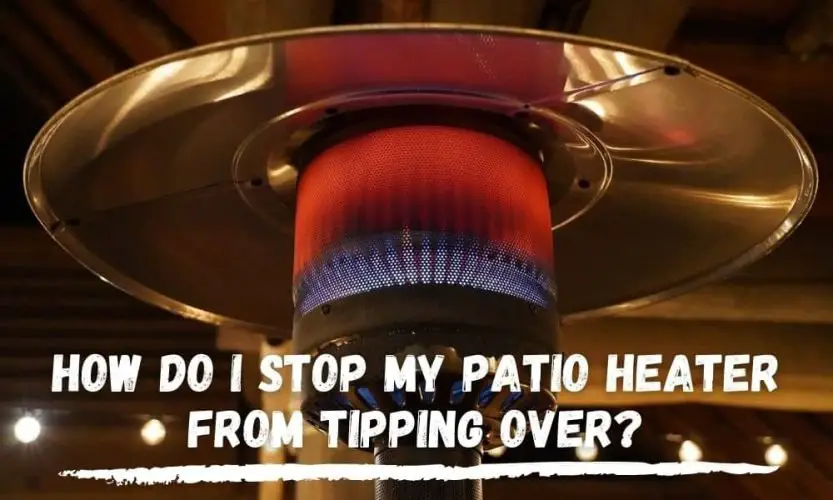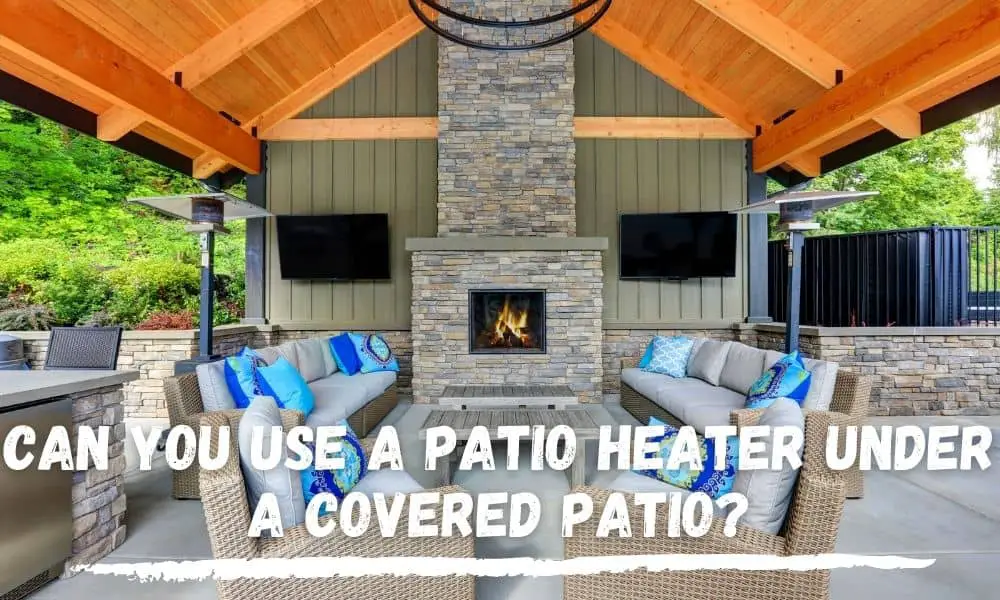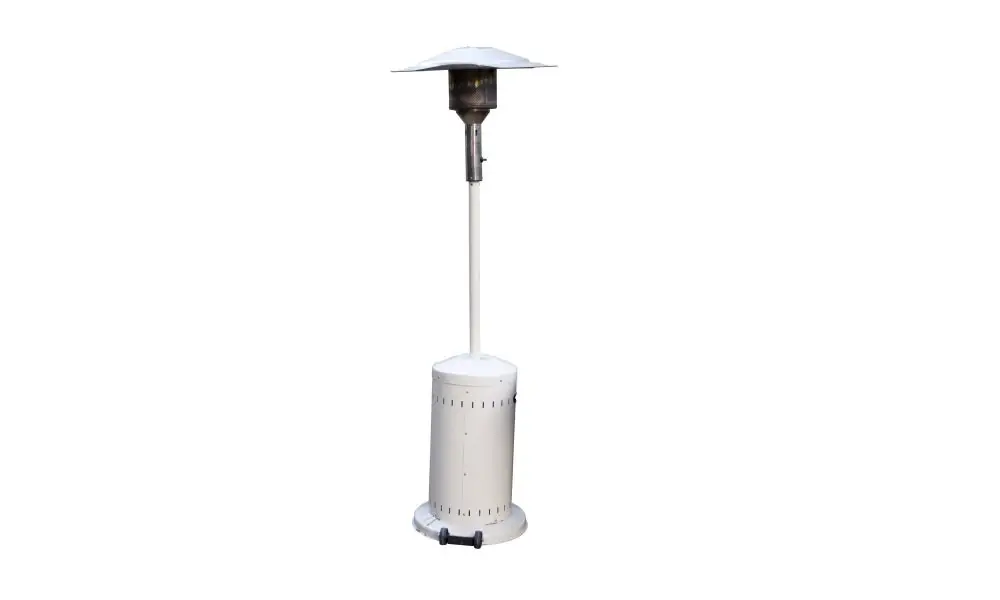Patio heaters have numerous anti-tipping features like broad and weighted bases. Still, toppling incidences are common. The results may be mild, like a slight bend to your patio heater or a devastating fire incident.

So how do you secure patio heaters to avoid toppling? We will cover COG lowering methods, fastening patio heaters, and topple-resistant heaters. Besides, we will also share why you need an anti-tilt switch plus child and pet care.
Quick Navigation
- Stabilizing Patio Heaters
- The Positioning of Your Patio Heater to Prevent Tipping
- Keep Your Patio Heater Away From Paths and Doors
- The Effect of Wind on Patio Heaters
- The Anti-tilt Feature on a Patio Heater
- Testing an Anti-tilting Switch
- Considering Mounted Heaters
- Purchasing a Natural Gas Patio Heaters
- Child and Pet Care
- Conclusion
Stabilizing Patio Heaters
The best way to prevent your backyard heater from tipping over is by stabilizing its bottom. You can stabilize your patio heater’s base in the following ways:
- Adding weight to it
- Securing it to a stabilized structure
- Fixing your unit to the ground
Each of these methods will enhance the stability of your patio heater. However, using all three methods is the best way to stabilize your unit immensely. The more caution you maintain, the lower the chances of tipping.
1. Adding Weight to Your Patio Heater
Weighing down your patio heater is the simplest solution to deter tipping. Most patio heaters have a broad top with a top heat reflector. Thus, the top tends to have more weight, which raises the COG(center of gravity). Adding weight to the base of your patio heater lowers the COG. Some of the ways to lower the COG of a patio heater include:
- You can utilize sand or water to fill its inbuilt propane tank reservoir. Most tabletop, standup, and pyramid propane heaters will have a reservoir for propane tanks. Therefore, you can fill this reservoir with water or sand to increase the weight at the bottom. When using water, ensure the container you use to place water in the reservoir is fire-resistant. The purpose of the container is that most reservoirs aren’t wholly solid to hold water independently. Make sure to look at your manufacturer’s guide for any requirements on weighing down using a reservoir.
Your heater may not have tank housing, especially if it is not a propane type heater. So how can you increase the weight on the base of a patio heater that has no reservoir?
- You can use fire-resistant objects to attach to the bottom of your patio heater. The most popular options include water weights and sandbags. However, sandbags don’t have an appealing look and may tamper with the appearance of your décor. Moreover, sandbags may tear and spill everywhere, giving you a tedious cleanup task. Still, they are excellent for stabilizing your patio heater. Water weights also lower the COG excellently.
Irrespective of the materials and methods you use to lower the COG, weighing down is an efficient way to prevent tipping.
2. Securing Your Patio Heater to a Stabilized Structure
Another brilliant way to enhance your patio heater’s stability is by fastening it to a stabilized structure. These may include using things like pillars or stone statues. Make sure you are using fire-resistant ties when fastening your patio heater to the stabilized structure.
An excellent example of a fire-resistant tie is a bungee cord. Attaching your patio heater to a stable substance gives you enhanced security on windy days.
Make sure the stabilized structure is fire-resistant. Some pillars may have oil paints, hence not ideal for fastening your patio heater.
3. Fixing Your Patio Heater to the Ground
Attaching your patio heater to the ground is the most effective method to stabilize your heater. If you are content with your outdoor space heater’s location, you can consider fixing it permanently. On ground fixtures, bolt your patio heater to secure it.
The Positioning of Your Patio Heater to Prevent Tipping
Besides the weighing down methods, you should also consider the place you put your patio heater. A safe location for your patio heater should meet the following conditions:
- The place should have proper ventilation.
- The place should have a level and a hardened floor. For example, you can fasten your patio heaters in places like decks and cemented sections.
- The place should be away from structures. For example, a dry branch from a tree can fall on your patio heater, causing it to topple.
Make sure to keep your patio heater off unstable areas. As much as it is okay to use patio heaters on grass (with specific considerations), it is not ideal for stability.
Even in well-manicured lawns, the grass surface is still uneven and can cause your patio heater to topple. The perfect place has even ground and can also allow you to fasten your patio heater.
Keep Your Patio Heater Away From Paths and Doors
While you want your patio heater in a convenient area, keep it off paths and doors. If you place your patio heater in such areas, the chances of someone knocking it are higher.
Besides, if you place your patio heater on a path, moving around it becomes a nuisance. When your patio heater is in a low-traffic area, your family and guests will have peace of mind.
The Effect of Wind on Patio Heaters
You might already know that windy conditions are not ideal to use a patio heater. Wind deters your outdoor patio heater from functioning effectively. Moreover, you can easily forget your outdoor patio heater on windy days if you didn’t use it. Therefore, make sure that your patio heater is under shelter during such times. Some other things you can implement to improve stability when handling patio heaters are;
- Ensure you safely secure your patio heater or weigh it down.
- You can enhance the stability of your patio heater by tying it down.
- Cover your patio heater when not using it. By covering, you will protect it from rain, snow, and dust damage. Consider the type of patio cover you are using, as this may impact your heater’s stability.
It is best to get a cover that snuggly fits onto your patio heater. If your patio heater cover is loose, it offers more room for air to enter, resulting in billowing. Moreover, it is best to pick a backyard heater cover that has air vents.
These will permit the free flow of air and prevent billowing during high winds. If your patio heater cover flails in the wind, it can cause your patio heater to topple.
Also, ensure that any furniture you place around your patio heater will not likely blow away. Plastic stools and chairs can get blown during windy conditions. So, ensure you weigh them down by placing materials on top of them like heavy pillows.
Still, you can tie them down for enhanced stability. To fasten outdoor furniture, some of the things you can use include:
- Deck anchors
- Bungee cords
- Bolts
- Sandbags
- Stacking them together when not in use
- Furniture weights
- Velcro and ties to keep cushions stationery.
The Anti-tilt Feature on a Patio Heater
Apart from a weighted base, several propane gas patio heaters will come with an anti-tilt switch. Although it doesn’t aid in patio heater stability, it will avoid devastating after-effects. Should your patio heater accidentally tip over, it will automatically shut off the heater.
As a result, it will deter gas leakage, which is only a spark away from razing down your covered patio and house.
Some propane patio heaters may not come with the anti-tilting switch. However, a few current models are compatible with switches. So, find out if your patio heater can accommodate an anti-tilt switch should it lack one.
Testing an Anti-tilting Switch
Testing the anti-tilting switch on your patio heater now and then is crucial. The best way of testing your anti-tilting switch is by using your patio heater manual. Although tipping your patio heater intentionally will indicate a fault, you shouldn’t try it. It may result in the gas leak that you are trying to prevent.
While you test the anti-tilting switch, consider a few issues.
- Ensure that you turn your patio heater off.
- Have clearance of around three feet all around your outdoor heater.
- Observe the usual precautions when dealing with patio heaters.
Besides preventing a gas leak, the anti-tilt switch ensures your patio heater has optimal performance. A faulty anti-tilting switch may result in a malfunction. It can extinguish the pilot flame once you turn your outdoor space heater on.
Locating the position of your anti-tilting switch is vital should you have to replace it. When conducting regular maintenance on your patio heater, always remember to check the anti-tilting switch.
Considering Mounted Heaters
With small outdoor spaces to heat, you can consider a mounted heater. Although they are typically electric, they still can heat patios adequately.
Mounted heaters have their merits and demerits. However, should they meet your needs, they are an excellent consideration as they have no stability issues.
Pros of Mounted Backyard Heaters
- Since you attach mounted heaters to walls, they won’t tip-over. Plus, you won’t get inconvenienced by the tedious task of weighing down your heater.
- With most of the mounted heaters being electric, you won’t have to worry about fuel supply like propane heaters.
- These electric patio heaters are off the ground, which gives you more room to conduct your activities. Besides, you won’t accidentally knock them.
- Numerous mounted heaters have a chic finish, which improves your décor. If the area you want to heat is expansive, you may consider getting several. They will become a part of your outdoor space layout without messing with the appearance.
Cons of Mounted Heaters
- A mounted heater isn’t as powerful as a propane heater since it is electric. One propane heater may have enough British Thermal Units to heat an expansive area. However, you may need several mounted heaters to heat the same size of space.
Hence, you will need to look at a few things before purchasing mounted electric heaters.
- You should consider the number of heaters that will adequately heat the area you desire.
- Check if you have ample wall space where you will mount them. You may have vines covering your gazebo or covered patio, and this may be challenging.
- The amount of power supply in your home will affect electric heater purchasing. You can calculate all the power that your appliances use. You can then determine whether adding electrical heaters is feasible or not.
- Also, consider the direction in which you want your heat to get directed.
Getting several mounted heaters can be tedious but still an excellent patio heating method. Besides, you won’t experience tipping incidences.
Purchasing a Natural Gas Patio Heaters
You can consider investing in natural gas heaters to heat outdoor spaces. Natural gas heaters will have a fixed connection to a natural gas line.
Thus, a natural gas heater will have a fixed location on the ground because of this gas line connection. Hence, you won’t have stability issues like many patio heaters.
Child and Pet Care
While your children and pets are playing, they may accidentally tip over your outdoor space heater. Ensure that you warn your children about the dangers of running around an outdoor area heater and other fire sources.
The safety measures you use on a fire pit are similar to the ones on patio heaters. However, some factors like the safe distance around a fire pit’s heating space and an outdoor space heater may vary. For instance, you can use many patio heaters to heat enclosed spaces than fire pits.
Moreover, your children may like to get close to the heater. Some models like the pyramid patio heaters have an attractive flame display. Always stay around to ensure your kids enjoy the show from a distance and not while touching the heater.
Conclusion
Preventing your patio heater from tipping is such an effortless task. Even with adequate measures to combat tip over, don’t forget to have an anti-tilt switch.
Especially in areas prone to earthquakes, stabilizing methods may be inadequate.
With a heightened risk of sparks and broken power cables during seismic activity, gas ignition chances are high. Therefore an anti-tilting switch is a vital gas-leak prevention device.





